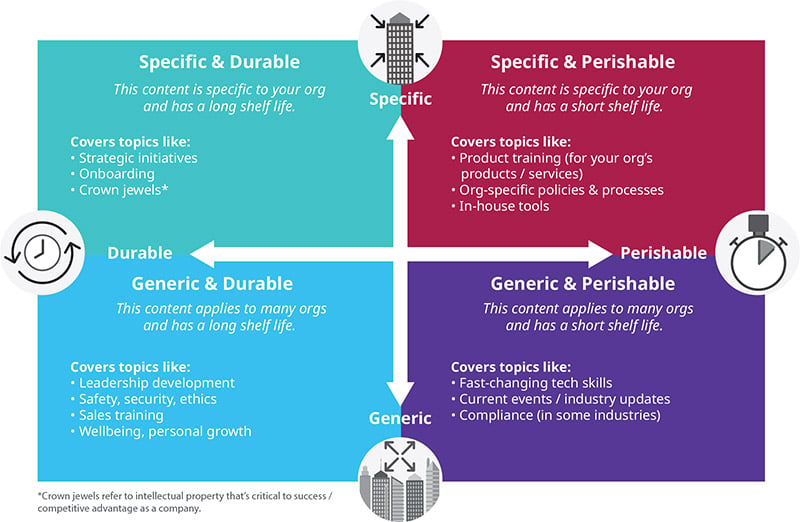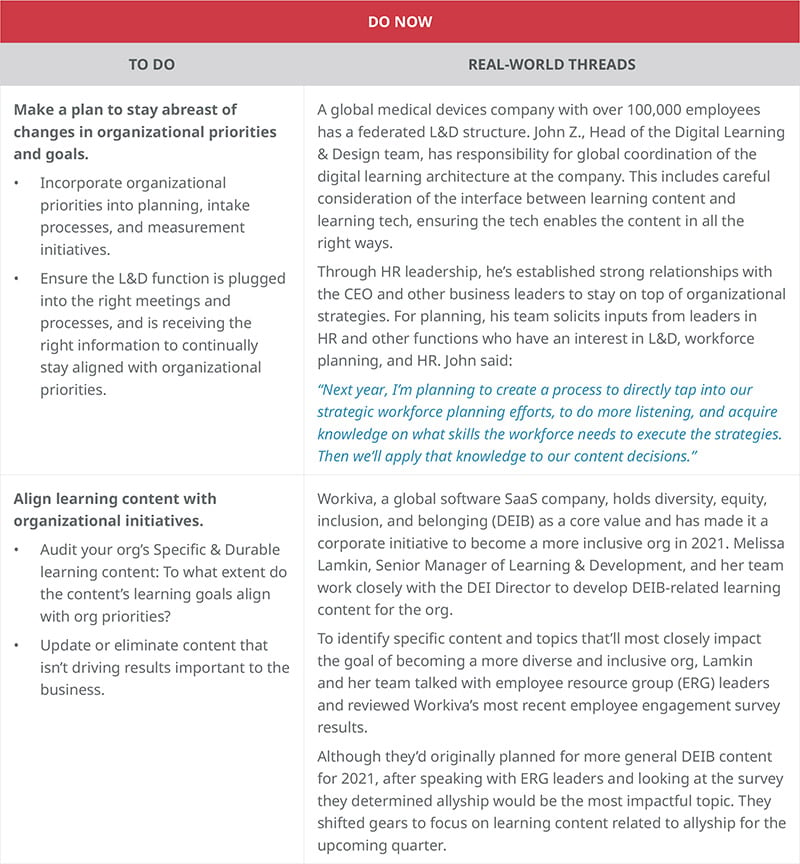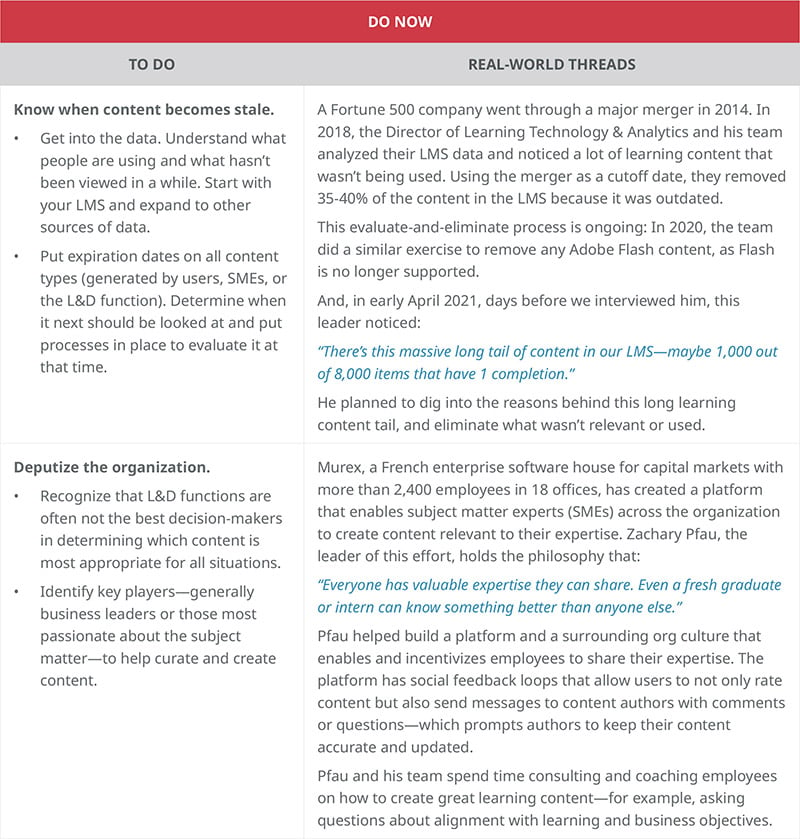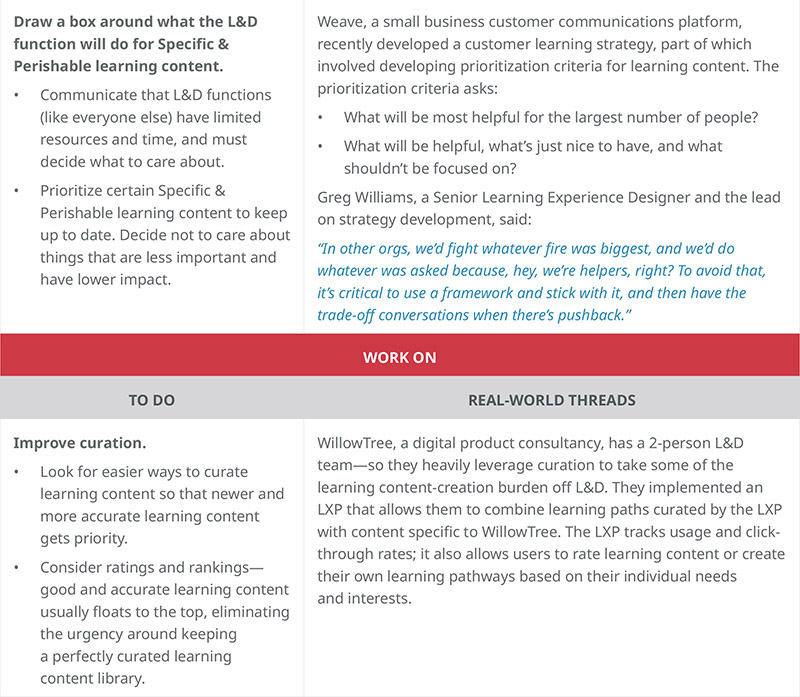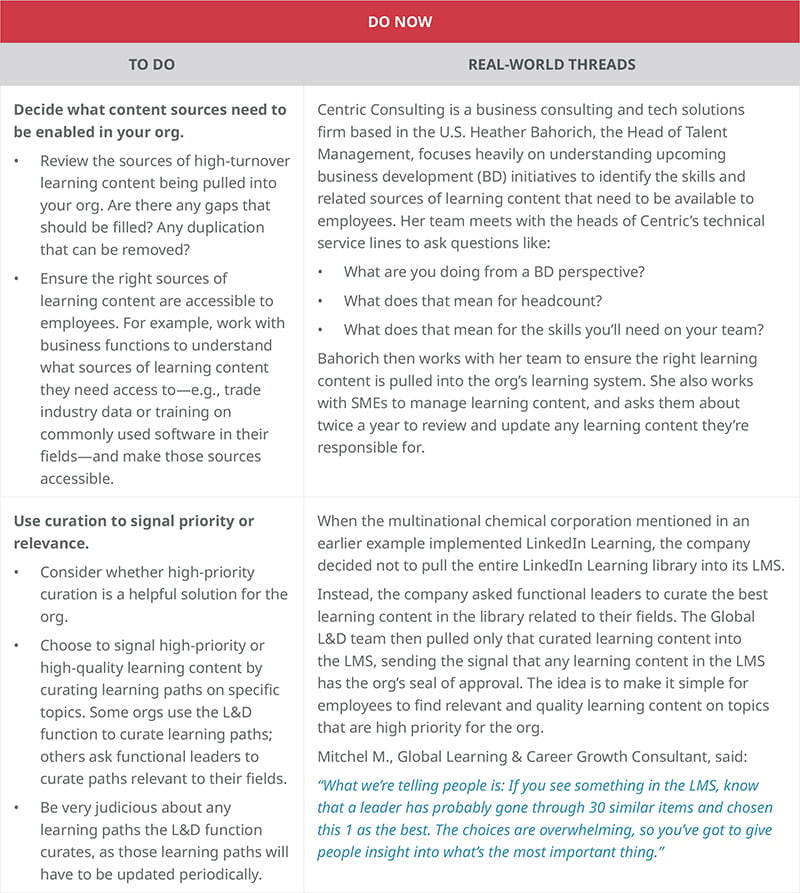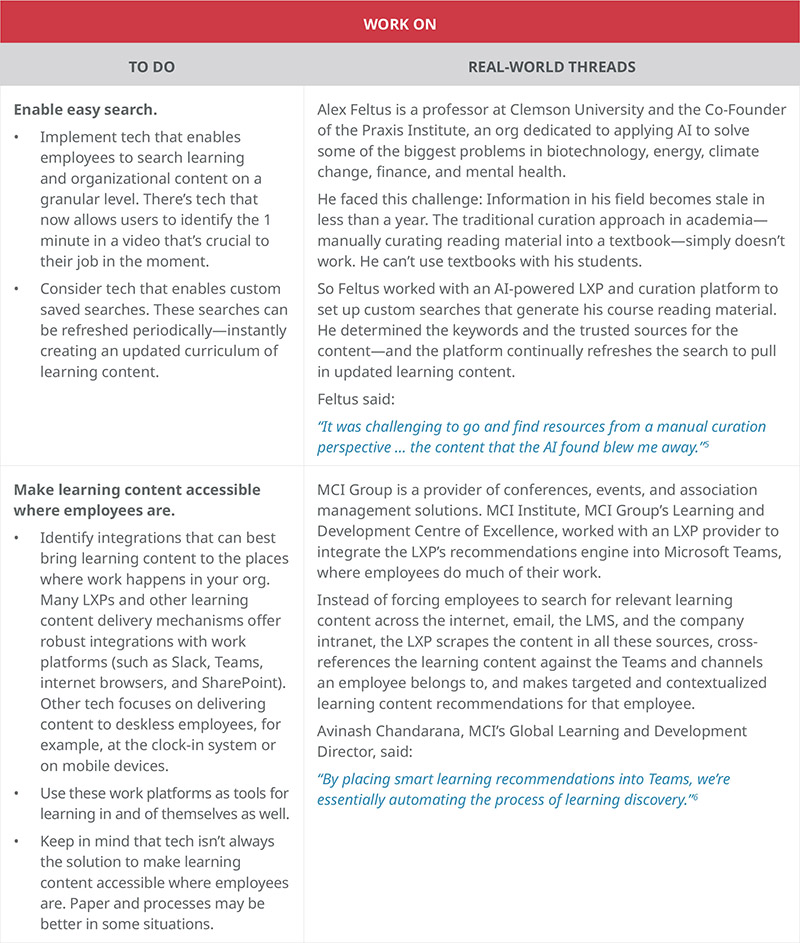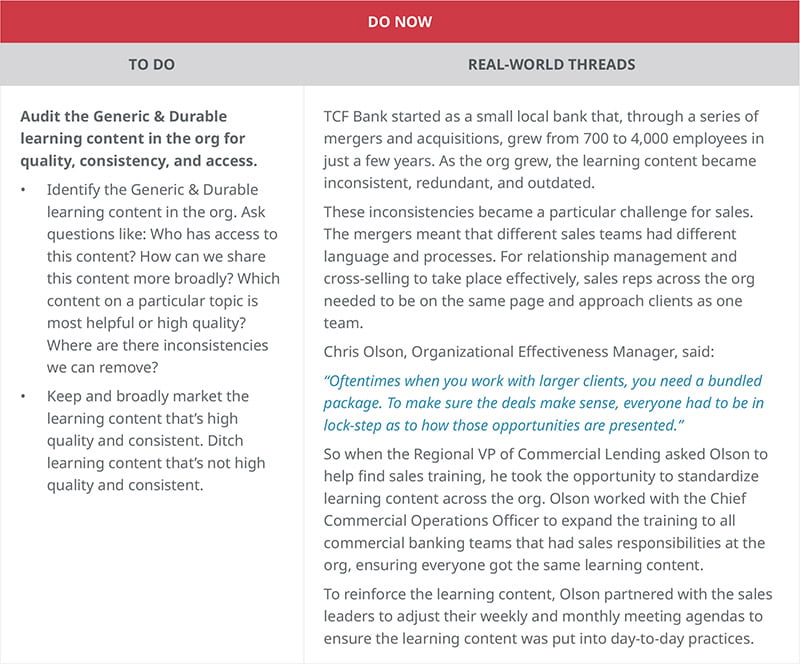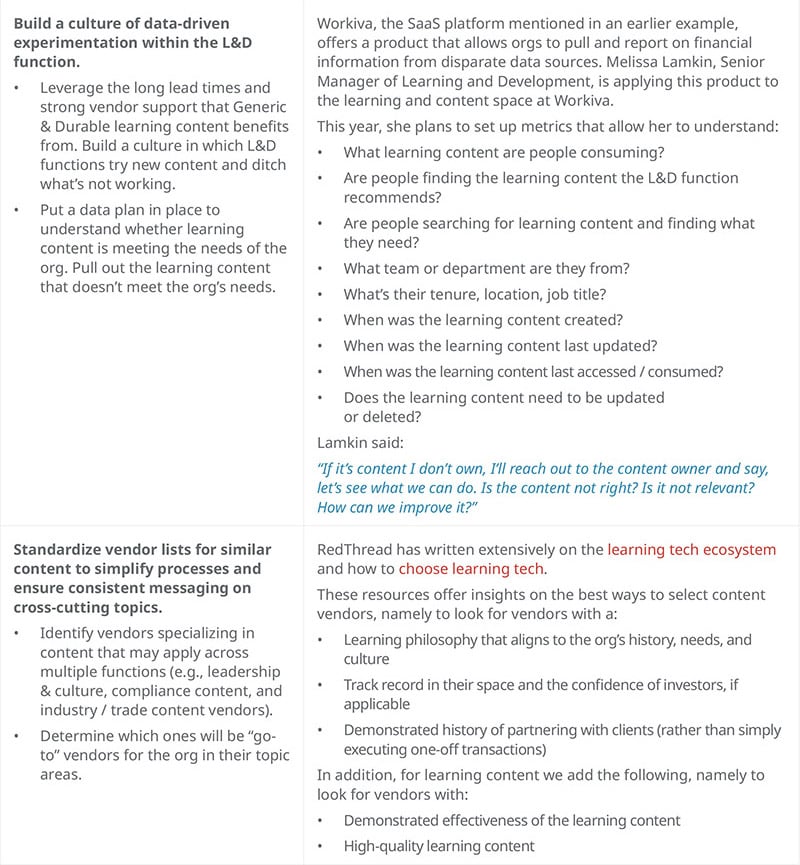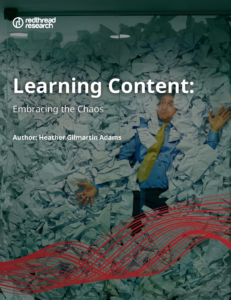Learning Content: Making Sense of the Chaos (Webinar Slides)
Posted on Tuesday, March 22nd, 2022 at 6:26 AM
These days, there’s learning content everywhere—inside and outside orgs; online and offline; in learning systems, email, chat platforms; and more. It’s chaos.
L&D functions must help employees navigate the chaos to find the content they need. They can start to do this by asking 2 questions about their learning content:
- How specific is the content to my org?
- How long is the content’s shelf life?
In this session, Dani Johnson and Heather Gilmartin Adams explored these 2 questions and presented RedThread’s latest research on learning content. Participants:
- Learned about current trends in content
- Explored a model that can inform a solid learning content strategy
- Saw how forward-thinking orgs are addressing common learning content challenges
Learning Content: Making Sense of the Chaos
Posted on Tuesday, June 29th, 2021 at 6:19 AM
We've been witnessing rapid growth in the amount, types, and sources of learning content. There’s more learning content everywhere—inside and outside orgs; online and offline; on desktops and mobile devices; and in learning systems, shared folders, browsers, email, and chat platforms.
It’s chaos.
L&D must help employees navigate this chaos, so they can find and consume the content that builds skills and drives outcomes that matter to the business. This infographic highlights key insights from our report, Learning Content: Embracing the Chaos, which introduced a new learning content model that helps learning leaders—and employees—make sense of the chaos.
Click on the image below to get the full infographic. As always, we’d love your feedback at [email protected]!
Learning Content: Embracing the Chaos
Posted on Wednesday, June 16th, 2021 at 4:49 PM
Key Takeaways
- Forward-thinking L&D functions make the chaos of learning content work for their orgs. Being overwhelmed by the surging quantities, types, and sources of learning content is yesterday’s news—but still today’s problem. Learning leaders are embracing the chaos and moving from providing content to enabling it, with an eye toward making more content available to all employees.
- Learning leaders should ask 2 questions about learning content: 1) Is it specific to the org? 2) How long is its shelf life (How durable is it)? Thinking in these 2 dimensions—specificity and durability—can help L&D functions clarify their learning content strategy and priorities.
- We developed a new model for learning content. From our conversations with forward-thinking learning leaders, we identified a model that breaks learning content into 4 categories (defined by the 2 dimensions of specificity and durability). This model can form the foundation of a learning content strategy that’s clear on priorities, roles & responsibilities, and areas of focus.
- There are distinct actions L&D functions can and should take to improve their learning content strategies—and those actions change based on the 4-category model of learning content introduced in this report. We provide some suggestions for immediate and longer-term actions to take, as well as examples of real orgs implementing these ideas, to help learning leaders organize the chaos and better manage learning content overall.
Why Talk About Learning Content Now?
We’ve been witnessing rapid growth in the amount of learning content available to employees. This growth started decades ago, but it’s recently turned from a trickle to a flood. There’s more learning content everywhere—inside and outside orgs; online and offline; on desktops and mobile devices; and in learning systems, shared folders, browsers, email, and chat platforms. Is it any wonder that employees are overwhelmed and exhausted by the sheer volume of all that’s available?1
Employees are overwhelmed and exhausted by the amount of learning content.
Employees feel like they’re drowning—and it’s L&D’s job to help them find and consume the content that builds skills and drives outcomes that matter to the business . To do this, L&D functions need well-crafted learning content strategies that support org learning and business strategies.
A learning content strategy should help L&D functions answer questions like:
- How will we decide what learning content to bring into the org?
- How will we identify—and help employees identify—learning content that’ll support our business and learning strategies?
- How and when will learning content be updated? By whom?
- How will we make the right learning content easily available to employees?
- What can we do immediately and in the longer term to improve employees’ ability to find and consume the learning content they need?
In this study—which included a lit review, roundtable, and interviews—we explored these questions. Through this research, we sought to identify the leading practices that orgs are using to help employees sift through the volume of learning content to find what’s right for them, when they need it.
L&D functions need well-crafted learning content strategies that support org learning and business strategies.
In the next section, we introduce the trends we uncovered as part of this study.
What’s Happening in Learning Content?
In the course of this research, we identified 4 trends in learning content that are helping shape the learning content strategies of forward-thinking orgs:
- More types and sources of learning content
- More enabling, less pushing of learning content by L&D functions
- More (and better) use of skills data to inform learning content priorities
- More access for all employees
In the following sections, we take a brief look at these 4 trends.
More types & sources of learning content
Not only is there more learning content in more places—but there are more types of content created by a wider variety of authors. Learning content used to be primarily created and controlled by L&D functions. Now, however, employees have access to:
- L&D function-created content
- Learning content created by subject-matter experts (SMEs)
- Company reports, policies, strategy docs, etc.
- Vendor-created learning content (custom or off the shelf)
- YouTube and other social media content
- Podcasts
- Conference notes, presentations, and videos
- Trade- or industry-specific content
- Learning content libraries (LinkedIn Learning, Udemy for Business, etc.)
- Subscriptions to learning content aggregators
- The entire internet
There’s not only more volume of content—there’s more types of content, in more places, created by a wider variety of authors.
And we know that’s not an exhaustive list.
The incredible volume, variety, and breadth of the learning content that’s available—over much of which L&D functions have limited control—complicate things for learning leaders and for employees.
Through our research, though, we found that learning leaders who’ve given this some thought don’t try to control the chaos. Instead, they embrace it—or, at least, they try to work with the reality that learning content is already complicated, and it’s only going to get bigger and more complex over time.
L&D functions can create systems, processes, and policies that help employees navigate the chaos of learning content.
Savvy learning leaders think about how to create systems, processes, and policies that help orgs and employees navigate through the chaos—rather than trying to tame the chaos itself (because that’s not gonna happen).
One learning leader noted:
“Learning functions need to recognize we never owned learning content in the first place, and we certainly don’t now. We need to embrace the chaos.”
Nick Halder, Senior Director of Talent, Snow Software
More enabling, less pushing by L&D functions
Given the increasing amount and variety of learning content out there, the move toward personalized development experiences, and the sheer variety of people in most orgs, it’s almost impossible for L&D functions to push the right content to the right people at the right time in the right format—all the time. There’s also a growing recognition that often the employee knows best—or at least has a good sense of—what they need to learn.
Learning leaders are thinking about how to enable employees to navigate to the right content themselves, rather than pushing content to employees.
Instead of trying to push learning content, L&D functions are thinking about how to enable employees to navigate to the right content themselves—by giving guidance and context about, for example, the org’s strategy and direction, skills that may be needed in the future, and how learning content is organized in the company. This guidance and context can create conditions that enable employees to find and consume learning content when and how they like, in ways that align with their needs and org goals.
More (& better) use of skills data to inform learning content priorities
Learning leaders we talked to noted that, in the past, L&D functions have sometimes pushed out learning content that wasn’t relevant or helpful to employees. These learning leaders see information about the skills employees and orgs need as a potential solution:
“Without insight into what skills are in demand and what skills people have, L&D tends to focus on the learning content we think people need. That’s rarely an effective approach.”
Participant, “New Trends in Learning Content & Content Management” Roundtable
Forward-thinking orgs are using information about the skills their workforce has and the skills it’ll need in the future to decide what learning content to prioritize. Learning leaders are making investments in learning content that can help close critical skills gaps.
Skills info can help orgs better understand what learning content to prioritize and invest in.
More access for all employees
In the last year or so, learning leaders have started taking a much closer look at how accessible learning content really is in their orgs: They’re recognizing the importance of making learning content more widely available to close skills gaps—and to help the business stay agile, responsive, and competitive.2
Three ways learning leaders can improve access include:
- Removing artificial barriers. Sometimes orgs give employees access to learning content on a “need-to-know” basis. But this logic creates unnecessary boundaries that could be removed unless they’re strategically justified—for example, intellectual property, safety / security, cost, or some other significant reason.
- Making learning content more discoverable. Sometimes great learning content is hidden in pockets or silos within the company. Orgs can find ways of making learning content easier to discover by implementing organization standards and really good search capabilities. They can also create a culture of discovery by removing unnecessary passwords and encouraging employees to poke around.
- Making learning content accessible on mobile. Learning content doesn’t just live on desktops anymore. Employees, particularly frontline workers, need access on their phones. This often means rethinking accessibility to LMSs or LXPs, as well as thinking mobile-first when creating new learning content.
Forward-thinking orgs are exploring ways to make learning content transparent, accessible, and appealing to all employees.
In brief
These 4 trends are currently shaping the learning content environment. In this research, we sought to understand how learning leaders are navigating these trends—and how these trends affect their goals, focus areas, challenges, and strategies for learning content.
We developed a learning content model that can help orgs think through their learning content strategies.
This inquiry resulted in a model that can help orgs think through their learning content strategies and make better decisions about where L&D functions should focus their time and resources. The next section introduces and explores this learning content model.
A Model for Thinking About Learning Content
We looked for similarities and differences between learning leaders’ approaches to learning content—and noticed that the learning leaders we spoke with take very different approaches to learning content based on 2 factors (or dimensions) of the learning content they’re working with:
- How unique the learning content is to their org (specificity). Are leaders dealing with learning content that applies specifically to their company or content that applies across orgs?
- The shelf life of the learning content (durability). Are leaders thinking mostly about learning content that needs to be updated rarely, or learning content that’s continually changing and regularly in jeopardy of being out of date? (Note: Long vs. short shelf life may differ from industry to industry and company to company. But, in general, we consider durable learning content to last 1 or more years without needing to be updated.)
If we plot learning content against these 2 dimensions (specificity and durability), then the content generally falls within 1 of the following 4 categories:
- Specific & Durable. Learning content that’s specific to 1 org and has a long shelf life
- Specific & Perishable. Learning content that’s specific to 1 org but changes often
- Generic & Perishable. Learning content that applies to many orgs and changes often
- Generic & Durable. Learning content that applies to many orgs and has a long shelf life
The learning content model, introduced in Figure 1, outlines these 4 categories and provides examples of some common topics that each category tends to cover.
Learning leaders might consider using this model to clarify the L&D function’s (and other stakeholders’) focus areas and roles regarding learning content. When we gave one learning leader—who happens to sit in a central L&D team within a federated system—a sneak peek at this model, he said:
“I like this model because it can help our L&D teams think about who owns what content. L&D sometimes tries to be all things to all people, but that’s not possible. In my company, we’re starting to be much more intentional about where each of our respective L&D teams are best-suited to play.”
John Z., Head of Digital Learning & Design, Global Medical Devices Company
Let’s look at each of these 4 categories in more detail. For each category, we discuss:
- The focus L&D functions should have for each learning content category
- Challenges specific to each learning content category
- How L&D functions can address those challenges in the immediate and longer terms
Specific & Durable
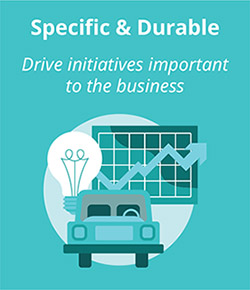 The Specific & Durable learning content category generally applies only to 1 org and has a relatively long shelf life. It tends to include:
The Specific & Durable learning content category generally applies only to 1 org and has a relatively long shelf life. It tends to include:
- Introductions to the org’s values, mission, philosophy, and how the org expects employees to act
- Info about strategic initiatives that define the org’s direction
- Onboarding training and materials
- “Crown jewels”—intellectual property that’s critical to success / competitive advantage as a company
The purpose of Specific & Durable learning content is often to shape organizational culture—helping employees understand “this is who we are” and “this is how we act.” Accordingly, the learning leaders we spoke with talked about Specific & Durable learning content most often in conjunction with organizational initiatives, such as organizational culture or change efforts; diversity, equity, inclusion, and belonging (DEIB); and strategic pivots (e.g., adapting to industry upheaval).
Specific & Durable learning content often helps shape org culture—by helping employees understand “this is who we are” and “this is how we act.”
L&D’s focus should be: Drive organizational initiatives
Forward-thinking orgs conceptualize the L&D function’s role—and related goals—differently, depending on the category of learning content at hand: They have a different focus for each of the 4 categories of learning content. As the nature of the learning content and its associated challenges change, so does the way the org thinks about where L&D functions should spend the most effort.
L&D should think about how Specific & Durable learning content can help move the needle in areas that are priorities for the business.
For Specific & Durable learning content, L&D functions should focus on driving organizational initiatives. Specifically, they should think about how Specific & Durable learning content can help move the needle in areas that are priorities for the business.
As one learning leader said:
“What’s the strategic change that’s happening? Is your learning content relevant to get to those organizational outcomes?”
Participant, “New Trends in Learning Content & Content Management” Roundtable
Importantly, learning leaders aren’t thinking about how L&D functions can drive org initiatives alone—far from it. Almost every learning leader we spoke with about Specific & Durable learning content described how they’re reaching outside of the L&D function—to other parts of HR and to leaders of other functions—to stay in sync with org priorities and use learning content to support the cultural and strategic initiatives important to the business.
Biggest challenges we heard
Because Specific & Durable learning content often links directly to key business initiatives, L&D functions typically face challenges like:
- Staying aligned with business goals. How do we stay agile and aligned with business goals in an ever-flexible environment?
- Driving change. How do we use learning content to move the org toward its goals?
- Measuring impact. How do we know if the learning content is, in fact, driving the change, creating the culture, or moving the needle in ways that align with the org’s priorities?
Intentionally linking learning content to org priorities is a critical component in addressing these challenges, particularly around measuring impact.
Forward-thinking L&D functions measure success against metrics used by the entire org, not just the L&D function.
In our research on measuring learning impact, we found that average L&D functions tend to triage based on the squeakiest wheel or easiest fix. Conversely, more forward-thinking L&D functions develop strategies and relationships to continually align and adjust learning content to support org goals—and to measure success against metrics used by the entire org, not just the L&D function.3
What L&D can do
In Figure 2, we include some ways L&D functions can start addressing these challenges. The ideas here (and in subsequent Figures 3-5) are divided into 2 sections:
- Do Now. Actions L&D functions can start on right away
- Work On. Actions requiring some time and coordination to implement
Each idea is paired with an example of how an org is implementing it.
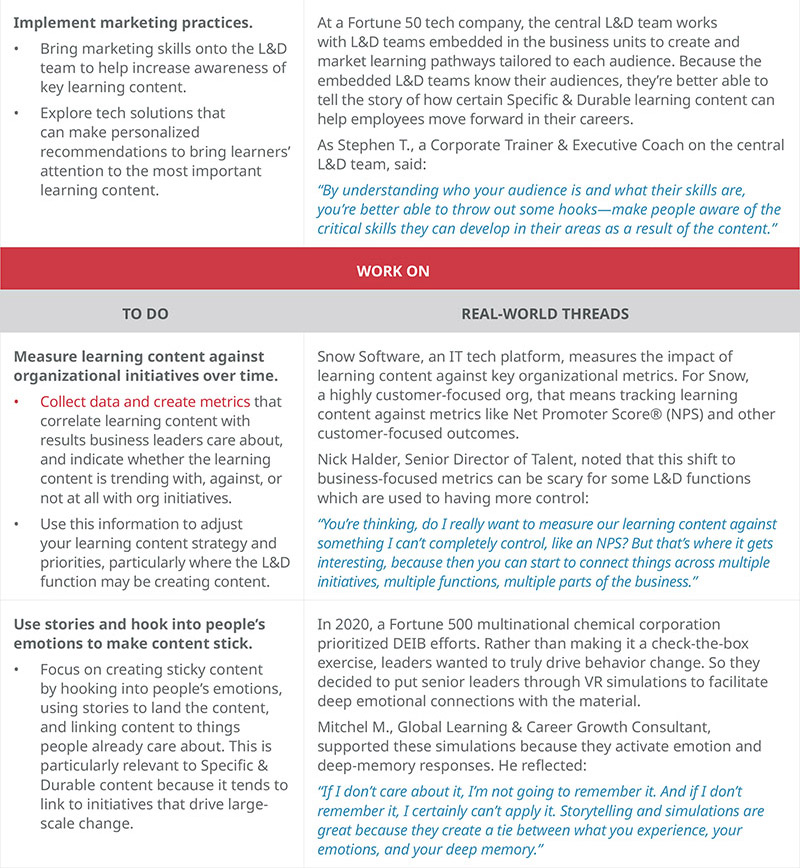
Figure 2: Ways L&D Can Help Address Challenges—Specific & Durable Learning Content | Source: RedThread Research, 2021.
Specific & Perishable
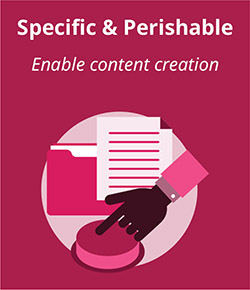 Specific & Perishable learning content is unique to the org and changes / needs updating relatively often. Examples of this type of learning content include:
Specific & Perishable learning content is unique to the org and changes / needs updating relatively often. Examples of this type of learning content include:
- Customer training (e.g., on the org’s products)
- Org-specific policies and processes
- Instructions and updates on internally built software / tools
A defining characteristic of Specific & Perishable learning content: The sources of the learning content exist all over the org—in policy and process documents, product release notes, wikis, etc. This truth, combined with the fact that the content changes often, means it’s exceedingly difficult (if not impossible) for L&D functions to create and update all Specific & Perishable learning content needed by the org.
L&D’s focus should be: Enable content creation
In contrast to orgs in which the L&D function tries to control learning content, orgs that deputize all employees and focus on enabling the creation of learning content—no matter who does the creating—tend to have much more success ensuring that updated learning content is available when needed.
The L&D function’s focus for Specific & Perishable learning content should be to enable the creation and curation of learning content within the org—not to create or control that learning content.
The most forward-thinking learning leaders we encountered approach learning content almost as a free-market economy problem: In their minds, L&D functions should facilitate the supply and demand of learning content. Their job is to make those supply / demand exchanges as frictionless as possible, both for the consumers of the learning content as well as the suppliers, no matter where they sit in the org.
Biggest challenges we heard
Challenges with Specific & Perishable learning content tend to stem from the fact that it needs to be updated frequently and only internal people (for the most part) can do the updating. Challenges include:
- Learning content becomes stale and is hard to keep updated
- The best learning content exists in lots of different places in the org
- Quality and consistency of learning content can vary, since a lot of the learning content isn’t created by the L&D function
We talked with several learning leaders who said their L&D teams struggle either to keep tons of content updated themselves or to incentivize SMEs across the business to keep their learning content updated.
L&D functions should provide processes, templates, and guidance to enable anyone in the org to create or curate learning content with relative ease, consistency, and quality.
To address these challenges, the learning leaders we spoke with focus on putting in place processes, templates, and guidance that enable anyone in the org to create or curate learning content with relative ease, consistency, and quality.
For example, these forward-thinking learning leaders:
- Implement basic instructional design templates and norms across the org
- Put in place tech that offers standard templates, design principles, and formatting
- Track learning content usage and communicate regularly with learning content authors about updates
- Make themselves available as consultants—answering questions and providing advice on how to create effective learning content that meets the standards they’ve set
What L&D can do
In Figure 3, we include some ways L&D functions can start addressing these challenges. Each idea also outlines how an org is implementing that idea.
Figure 3: Ways L&D Can Help Address Challenges—Specific & Perishable Learning Content | Source: RedThread Research, 2021.4
Generic & Perishable
 Generic & Perishable learning content can apply to many orgs but has a short shelf life. Examples of Generic & Perishable learning content include:
Generic & Perishable learning content can apply to many orgs but has a short shelf life. Examples of Generic & Perishable learning content include:
- Training / updates on fast-changing tech skills
- How-to tutorials on common processes (e.g., how to create a QR code, how to use a function in Excel)
- Info on current events and industry / market updates
Generic & Perishable learning content is defined by its sheer volume—and the fact that it’s everywhere.
The defining characteristic of this learning content category is sheer volume: There’s so much of it, everywhere! Much Generic & Perishable learning content is available for free online, although Google and YouTube are certainly not the only ways to find it. Other sources of Generic & Perishable learning content are, for example:
- Learning content libraries like PluralSight and LinkedIn Learning
- Professional or trade publications and websites
- Tech vendors offering learning content on how to use their software
Generic & Perishable learning content also changes frequently, meaning the great video someone found last year might be 3 releases out of date this year.
L&D’s focus should be: Help employees filter to the right learning content
The nature of Generic & Perishable learning content means L&D functions’ focus should be to help employees filter. It would be incredibly difficult to provide just the right info to each employee when they need it. Rather, learning leaders’ job is to create conditions that enable employees to cut through the noise and find what they need.
L&D functions should create conditions that enable employees to cut through the noise and volume of learning content to find what they need.
In most orgs, helping employees “filter” means using some kind of tech, most commonly an LXP. We’ve yet to see an org set up a completely manual process that enables filtering at the scale most orgs need: Most orgs leverage both tech and humans to get the job done. For example, teams may share the best or most helpful learning content with one another via Teams or Slack; they may set up queries in content aggregators like Feedly and other apps.
Biggest challenges we heard
We heard 2 main challenges related to Generic & Perishable learning content, both stemming from the volume and turnover common to this learning content category:
- There’s too much noise. For Generic & Perishable learning content, the “signal-to-noise” ratio is extremely low: There’s a lot of learning content in this category, but quality and relevance vary. Although it may be easy to find some learning content on a particular topic or question, it’s hard to know whether it’s the best learning content—or what the org would want an employee to rely on.
- Finding the latest and greatest. There’s regularly more and better learning content somewhere out there. Employees have a hard time finding the most updated, most relevant stuff.
Implementing effective search, curation, and recommendation engines can help give employees direction and a place to start.
Implementing effective search, curation, and recommendation engines can help address these challenges by giving employees direction and a place to start. We explore these ideas next.
What L&D can do
In Figure 4, we include some ways L&D functions can start addressing these challenges. Each idea also outlines how an org is implementing that idea.
Figure 4: Ways L&D Can Help Address Challenges—Generic & Perishable Learning Content | Source: RedThread Research, 2021.5,6
Generic & Durable
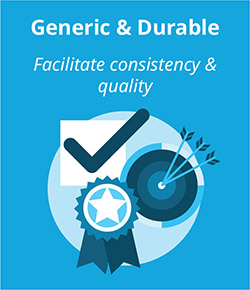 Generic & Durable learning content changes relatively infrequently and applies to many orgs. It includes learning content such as:
Generic & Durable learning content changes relatively infrequently and applies to many orgs. It includes learning content such as:
- Education and refreshers on safety, security, and ethics
- Leadership development training and programs
- Industry-specific background / context (e.g., how the banking system works)
- Learning content to develop sales skills
- Support for employee wellbeing, mindfulness, and personal growth
Because Generic & Durable learning content can apply to many orgs and likely isn’t changing at a breakneck pace, quite a few learning content vendors play in this space. These vendors offer high-quality learning content on specialty topics that an in-house L&D team may not have the expertise or bandwidth to create.
Many Generic & Durable learning content vendors offer high-quality learning content on specialty topics that an in-house L&D team may not have the expertise or bandwidth to create.
L&D’s focus should be: Facilitate consistency & quality
L&D functions’ focus for Generic & Durable learning content should be facilitating consistency and quality—setting standards for what quality learning content looks like across the org. Because so many vendors offer different learning content at varying levels of quality, L&D functions can create value by helping the org define standards that outline, for example:
- The “go-to” vendors to work with on cross-functional topics like leadership, industry context, or wellbeing
- Criteria for selecting vendors not on the “go-to” list
- What high-quality learning content looks like and where it’s coming from
- Ways to measure / understand what learning content is working and what’s not
L&D functions should define standards that outline, for example, go-to vendors, vendor selection criteria, and what “high-quality” learning content looks like for the org.
With these standards (and / or others) in place, L&D functions can provide a consistent, org-wide point of view on cross-cutting topics, like “the way we lead,” “the way we think about safety,” and so on.
Biggest challenges we heard
Consistency and quality are the primary challenges for Generic & Durable learning content because much of the learning content can apply to many different functions (think leadership development or safety / security) and so many commercial sources of this category of learning content exist.
This breadth and variety give rise to potential differences—within the same org—in:
- The content that’s used for learning on a particular subject
- The quality or efficacy of that learning content
- How that learning content is delivered or supported
- Who gets access to the learning content
- The processes used to evaluate the learning content
As an example, we’ve seen orgs that use a dozen or more different leadership models because different functions / teams brought in different leadership vendors / consultants at different times.
Forward-thinking L&D functions consider how they can foster relationships—with vendors and other functions—to ensure consistency and quality of learning content across the org.
In the lit review we did as part of this research, we read several articles on creating consistent learning content. In an org, consistent course design and visual cues across as much learning content as possible can go a long way toward helping employees understand and navigate learning content easily. However, this kind of consistency is sometimes difficult to achieve with externally created content.
In addition to these instructional design elements, forward-thinking L&D functions are also considering how they can foster relationships—with vendors and with other functions—to bring people together across silos in order to ensure consistency and quality of learning content throughout the org. This sometimes means convening cross-functional groups to align on needs, pool resources, or negotiate org-level (rather than function- or team-level) contracts with vendors.
What L&D can do
In Figure 5, we include some ways L&D functions can start addressing these challenges. Each idea also outlines how an org is implementing that idea.
Figure 5: Ways L&D Can Help Address Challenges—Generic & Durable Learning Content | Source: RedThread Research, 2021.
Wrap-Up
We’ve given you a snapshot of recent trends in learning content, including how the explosion in volume and variety of learning content is affecting orgs and employees alike. We’ve also introduced a model for thinking about learning content in 4 categories, based on 2 key factors:
- The specificity of the learning content to the org
- The durability (or shelf life) of the learning content
Our biggest takeaway from this study is how the 4 different categories of learning content give rise to very different focuses for L&D functions—different conceptions of what L&D functions should do with regard to that learning content—and have very different associated challenges. (Unsurprisingly, there’s no one-size-fits-all learning content strategy.)
We are grateful to those learning leaders who shared their experiences and examples with us, and are excited to share so many concrete examples in this report.
As always, we welcome feedback and discussion! Please feel free to reach out to RedThread Research at [email protected] or www.redthreadresearch.com. We’d love to hear about your experiences.
Appendix 1: Research Methodology
We launched our study in Spring 2021. This report gathers and synthesizes findings from our research efforts, which include:
- A literature review of 51 articles from business, trade, and popular lit sources
- 1 roundtable with a total of 33 participants
- 15 in-depth interviews with learning leaders about their experiences and thoughts on learning content
For those looking for specific information that came out of those efforts, you’re in luck: We’ve a policy of sharing as much information as possible throughout the research process. Please see:
- Premise: “Content in the 2020s: Enabling Learning”
- Lit review: “Learning Content in the 2020s: What the Literature Says”
- Roundtable readout: “Trends in Learning Content & Content Management”
- Q&A call: "Learning Content"
Appendix 2: Contributors
Thank you so much to those of you who participated in our roundtable and interviews. We couldn’t have done this research without you! In addition to the leaders listed below, there are many others we can’t name publicly. We extend our gratitude nonetheless: You know who you are.
Angel Rodriguez
Ann Boldt
Brett Rose
Bria Dimke
Brian Richardson
Catherine Marchand
Chris Casement
Chris Olson
Clark Shah-Nelson
Eddie Garcia
Emily Crockett
Erik Soerhaug
Gordon O’Reilly
Greg Williams
Heather Bahorich
Ian Bolderstone
Jihyun Jeong
Jim Maddock
John Z.
Laurence D. Banner
Leah Holmgren
Marc Ramos
Martin Tanguay
Melissa Lamkin
Mitchel M.
Nick Halder
Nicole Leret
Robert Young
Sarah Foster
Shaun Rozyn
Stephanie Fritz
Stephen T.
Tania Tiippana
Tone Reierselmoen
Zachary Pfau
In addition, we thank Catherine Coughlin for editing the report, Jennifer Hines for graphics, Jenny Barandich for the layout, and Sana Lall-Trail for research and project management.
Learning Content: Embracing the Chaos
Posted on Tuesday, June 15th, 2021 at 10:29 AM
Key Takeaways
- Forward-thinking L&D functions make the chaos of learning content work for their orgs. Being overwhelmed by the surging quantities, types, and sources of learning content is yesterday’s news—but still today’s problem. Learning leaders are embracing the chaos and moving from providing content to enabling it, with an eye toward making more content available to all employees.
- Learning leaders should ask 2 questions about learning content: 1) Is it specific to the org? 2) How long is its shelf life (How durable is it)? Thinking in these 2 dimensions—specificity and durability—can help L&D functions clarify their learning content strategy and priorities.
- We developed a new model for learning content. From our conversations with forward-thinking learning leaders, we identified a model that breaks learning content into 4 categories (defined by the 2 dimensions of specificity and durability). This model can form the foundation of a learning content strategy that’s clear on priorities, roles & responsibilities, and areas of focus.
- There are distinct actions L&D functions can and should take to improve their learning content strategies—and those actions change based on the 4-category model of learning content introduced in this report. We provide some suggestions for immediate and longer-term actions to take, as well as examples of real orgs implementing these ideas, to help learning leaders organize the chaos and better manage learning content overall.
Why Talk About Learning Content Now?
We’ve been witnessing rapid growth in the amount of learning content available to employees. This growth started decades ago, but it’s recently turned from a trickle to a flood. There’s more learning content everywhere—inside and outside orgs; online and offline; on desktops and mobile devices; and in learning systems, shared folders, browsers, email, and chat platforms. Is it any wonder that employees are overwhelmed and exhausted by the sheer volume of all that’s available?1
Employees are overwhelmed and exhausted by the amount of learning content.
Employees feel like they’re drowning—and it’s L&D’s job to help them find and consume the content that builds skills and drives outcomes that matter to the business. To do this, L&D functions need well-crafted learning content strategies that support org learning and business strategies.
A learning content strategy should help L&D functions answer questions like:
- How will we decide what learning content to bring into the org?
- How will we identify—and help employees identify—learning content that’ll support our business and learning strategies?
- How and when will learning content be updated? By whom?
- How will we make the right learning content easily available to employees?
- What can we do immediately and in the longer term to improve employees’ ability to find and consume the learning content they need?
In this study—which included a lit review, roundtable, and interviews—we explored these questions. Through this research, we sought to identify the leading practices that orgs are using to help employees sift through the volume of learning content to find what’s right for them, when they need it.
L&D functions need well-crafted learning content strategies that support org learning and business strategies.
In the next section, we introduce the trends we uncovered as part of this study.
What’s Happening in Learning Content?
In the course of this research, we identified 4 trends in learning content that are helping shape the learning content strategies of forward-thinking orgs:
- More types and sources of learning content
- More enabling, less pushing of learning content by L&D functions
- More (and better) use of skills data to inform learning content priorities
- More access for all employees
In the following sections, we take a brief look at these 4 trends.
More types & sources of learning content
Not only is there more learning content in more places—but there are more types of content created by a wider variety of authors. Learning content used to be primarily created and controlled by L&D functions. Now, however, employees have access to:
- L&D function-created content
- Learning content created by subject-matter experts (SMEs)
- Company reports, policies, strategy docs, etc.
- Vendor-created learning content (custom or off the shelf)
- YouTube and other social media content
- Podcasts
- Conference notes, presentations, and videos
- Trade- or industry-specific content
- Learning content libraries (LinkedIn Learning, Udemy for Business, etc.)
- Subscriptions to learning content aggregators
- The entire internet
There’s not only more volume of content—there’s more types of content, in more places, created by a wider variety of authors.
And we know that’s not an exhaustive list.
The incredible volume, variety, and breadth of the learning content that’s available—over much of which L&D functions have limited control—complicate things for learning leaders and for employees.
Through our research, though, we found that learning leaders who’ve given this some thought don’t try to control the chaos. Instead, they embrace it—or, at least, they try to work with the reality that learning content is already complicated, and it’s only going to get bigger and more complex over time.
L&D functions can create systems, processes, and policies that help employees navigate the chaos of learning content.
Savvy learning leaders think about how to create systems, processes, and policies that help orgs and employees navigate through the chaos—rather than trying to tame the chaos itself (because that’s not gonna happen).
One learning leader noted:
“Learning functions need to recognize we never owned learning content in the first place, and we certainly don’t now. We need to embrace the chaos.”
Nick Halder, Senior Director of Talent, Snow Software
More enabling, less pushing by L&D functions
Given the increasing amount and variety of learning content out there, the move toward personalized development experiences, and the sheer variety of people in most orgs, it’s almost impossible for L&D functions to push the right content to the right people at the right time in the right format—all the time. There’s also a growing recognition that often the employee knows best—or at least has a good sense of—what they need to learn.
Learning leaders are thinking about how to enable employees to navigate to the right content themselves, rather than pushing content to employees.
Instead of trying to push learning content, L&D functions are thinking about how to enable employees to navigate to the right content themselves—by giving guidance and context about, for example, the org’s strategy and direction, skills that may be needed in the future, and how learning content is organized in the company. This guidance and context can create conditions that enable employees to find and consume learning content when and how they like, in ways that align with their needs and org goals.
More (& better) use of skills data to inform learning content priorities
Learning leaders we talked to noted that, in the past, L&D functions have sometimes pushed out learning content that wasn’t relevant or helpful to employees. These learning leaders see information about the skills employees and orgs need as a potential solution:
“Without insight into what skills are in demand and what skills people have, L&D tends to focus on the learning content we think people need. That’s rarely an effective approach.”
Participant, “New Trends in Learning Content & Content Management” Roundtable
Forward-thinking orgs are using information about the skills their workforce has and the skills it’ll need in the future to decide what learning content to prioritize. Learning leaders are making investments in learning content that can help close critical skills gaps.
Skills info can help orgs better understand what learning content to prioritize and invest in.
More access for all employees
In the last year or so, learning leaders have started taking a much closer look at how accessible learning content really is in their orgs: They’re recognizing the importance of making learning content more widely available to close skills gaps—and to help the business stay agile, responsive, and competitive.2
Three ways learning leaders can improve access include:
- Removing artificial barriers. Sometimes orgs give employees access to learning content on a “need-to-know” basis. But this logic creates unnecessary boundaries that could be removed unless they’re strategically justified—for example, intellectual property, safety / security, cost, or some other significant reason.
- Making learning content more discoverable. Sometimes great learning content is hidden in pockets or silos within the company. Orgs can find ways of making learning content easier to discover by implementing organization standards and really good search capabilities. They can also create a culture of discovery by removing unnecessary passwords and encouraging employees to poke around.
- Making learning content accessible on mobile. Learning content doesn’t just live on desktops anymore. Employees, particularly frontline workers, need access on their phones. This often means rethinking accessibility to LMSs or LXPs, as well as thinking mobile-first when creating new learning content.
Forward-thinking orgs are exploring ways to make learning content transparent, accessible, and appealing to all employees.
In brief
These 4 trends are currently shaping the learning content environment. In this research, we sought to understand how learning leaders are navigating these trends—and how these trends affect their goals, focus areas, challenges, and strategies for learning content.
We developed a learning content model that can help orgs think through their learning content strategies.
This inquiry resulted in a model that can help orgs think through their learning content strategies and make better decisions about where L&D functions should focus their time and resources. The next section introduces and explores this learning content model.
A Model for Thinking About Learning Content
We looked for similarities and differences between learning leaders’ approaches to learning content—and noticed that the learning leaders we spoke with take very different approaches to learning content based on 2 factors (or dimensions) of the learning content they’re working with:
- How unique the learning content is to their org (specificity). Are leaders dealing with learning content that applies specifically to their company or content that applies across orgs?
- The shelf life of the learning content (durability). Are leaders thinking mostly about learning content that needs to be updated rarely, or learning content that’s continually changing and regularly in jeopardy of being out of date? (Note: Long vs. short shelf life may differ from industry to industry and company to company. But, in general, we consider durable learning content to last 1 or more years without needing to be updated.)
If we plot learning content against these 2 dimensions (specificity and durability), then the content generally falls within 1 of the following 4 categories:
- Specific & Durable. Learning content that’s specific to 1 org and has a long shelf life
- Specific & Perishable. Learning content that’s specific to 1 org but changes often
- Generic & Perishable. Learning content that applies to many orgs and changes often
- Generic & Durable. Learning content that applies to many orgs and has a long shelf life
The learning content model, introduced in Figure 1, outlines these 4 categories and provides examples of some common topics that each category tends to cover.
Learning leaders might consider using this model to clarify the L&D function’s (and other stakeholders’) focus areas and roles regarding learning content. When we gave one learning leader—who happens to sit in a central L&D team within a federated system—a sneak peek at this model, he said:
“I like this model because it can help our L&D teams think about who owns what content. L&D sometimes tries to be all things to all people, but that’s not possible. In my company, we’re starting to be much more intentional about where each of our respective L&D teams are best-suited to play.”
John Z., Head of Digital Learning & Design, Global Medical Devices Company
Let’s look at each of these 4 categories in more detail. For each category, we discuss:
- The focus L&D functions should have for each learning content category
- Challenges specific to each learning content category
- How L&D functions can address those challenges in the immediate and longer terms
Specific & Durable
 The Specific & Durable learning content category generally applies only to 1 org and has a relatively long shelf life. It tends to include:
The Specific & Durable learning content category generally applies only to 1 org and has a relatively long shelf life. It tends to include:
- Introductions to the org’s values, mission, philosophy, and how the org expects employees to act
- Info about strategic initiatives that define the org’s direction
- Onboarding training and materials
- “Crown jewels”—intellectual property that’s critical to success / competitive advantage as a company
The purpose of Specific & Durable learning content is often to shape organizational culture—helping employees understand “this is who we are” and “this is how we act.” Accordingly, the learning leaders we spoke with talked about Specific & Durable learning content most often in conjunction with organizational initiatives, such as organizational culture or change efforts; diversity, equity, inclusion, and belonging (DEIB); and strategic pivots (e.g., adapting to industry upheaval).
Specific & Durable learning content often helps shape org culture—by helping employees understand “this is who we are” and “this is how we act.”
L&D’s focus should be: Drive organizational initiatives
Forward-thinking orgs conceptualize the L&D function’s role—and related goals—differently, depending on the category of learning content at hand: They have a different focus for each of the 4 categories of learning content. As the nature of the learning content and its associated challenges change, so does the way the org thinks about where L&D functions should spend the most effort.
L&D should think about how Specific & Durable learning content can help move the needle in areas that are priorities for the business.
For Specific & Durable learning content, L&D functions should focus on driving organizational initiatives. Specifically, they should think about how Specific & Durable learning content can help move the needle in areas that are priorities for the business.
As one learning leader said:
“What’s the strategic change that’s happening? Is your learning content relevant to get to those organizational outcomes?”
Participant, “New Trends in Learning Content & Content Management” Roundtable
Importantly, learning leaders aren’t thinking about how L&D functions can drive org initiatives alone—far from it. Almost every learning leader we spoke with about Specific & Durable learning content described how they’re reaching outside of the L&D function—to other parts of HR and to leaders of other functions—to stay in sync with org priorities and use learning content to support the cultural and strategic initiatives important to the business.
Biggest challenges we heard
Because Specific & Durable learning content often links directly to key business initiatives, L&D functions typically face challenges like:
- Staying aligned with business goals. How do we stay agile and aligned with business goals in an ever-flexible environment?
- Driving change. How do we use learning content to move the org toward its goals?
- Measuring impact. How do we know if the learning content is, in fact, driving the change, creating the culture, or moving the needle in ways that align with the org’s priorities?
Intentionally linking learning content to org priorities is a critical component in addressing these challenges, particularly around measuring impact.
Forward-thinking L&D functions measure success against metrics used by the entire org, not just the L&D function.
In our research on measuring learning impact, we found that average L&D functions tend to triage based on the squeakiest wheel or easiest fix. Conversely, more forward-thinking L&D functions develop strategies and relationships to continually align and adjust learning content to support org goals—and to measure success against metrics used by the entire org, not just the L&D function.3
What L&D can do
In Figure 2, we include some ways L&D functions can start addressing these challenges. The ideas here (and in subsequent Figures 3-5) are divided into 2 sections:
- Do Now. Actions L&D functions can start on right away
- Work On. Actions requiring some time and coordination to implement
Each idea is paired with an example of how an org is implementing it.

Figure 2: Ways L&D Can Help Address Challenges—Specific & Durable Learning Content | Source: RedThread Research, 2021.
Specific & Perishable
 Specific & Perishable learning content is unique to the org and changes / needs updating relatively often. Examples of this type of learning content include:
Specific & Perishable learning content is unique to the org and changes / needs updating relatively often. Examples of this type of learning content include:
- Customer training (e.g., on the org’s products)
- Org-specific policies and processes
- Instructions and updates on internally built software / tools
A defining characteristic of Specific & Perishable learning content: The sources of the learning content exist all over the org—in policy and process documents, product release notes, wikis, etc. This truth, combined with the fact that the content changes often, means it’s exceedingly difficult (if not impossible) for L&D functions to create and update all Specific & Perishable learning content needed by the org.
L&D’s focus should be: Enable content creation
In contrast to orgs in which the L&D function tries to control learning content, orgs that deputize all employees and focus on enabling the creation of learning content—no matter who does the creating—tend to have much more success ensuring that updated learning content is available when needed.
The L&D function’s focus for Specific & Perishable learning content should be to enable the creation and curation of learning content within the org—not to create or control that learning content.
The most forward-thinking learning leaders we encountered approach learning content almost as a free-market economy problem: In their minds, L&D functions should facilitate the supply and demand of learning content. Their job is to make those supply / demand exchanges as frictionless as possible, both for the consumers of the learning content as well as the suppliers, no matter where they sit in the org.
Biggest challenges we heard
Challenges with Specific & Perishable learning content tend to stem from the fact that it needs to be updated frequently and only internal people (for the most part) can do the updating. Challenges include:
- Learning content becomes stale and is hard to keep updated
- The best learning content exists in lots of different places in the org
- Quality and consistency of learning content can vary, since a lot of the learning content isn’t created by the L&D function
We talked with several learning leaders who said their L&D teams struggle either to keep tons of content updated themselves or to incentivize SMEs across the business to keep their learning content updated.
L&D functions should provide processes, templates, and guidance to enable anyone in the org to create or curate learning content with relative ease, consistency, and quality.
To address these challenges, the learning leaders we spoke with focus on putting in place processes, templates, and guidance that enable anyone in the org to create or curate learning content with relative ease, consistency, and quality.
For example, these forward-thinking learning leaders:
- Implement basic instructional design templates and norms across the org
- Put in place tech that offers standard templates, design principles, and formatting
- Track learning content usage and communicate regularly with learning content authors about updates
- Make themselves available as consultants—answering questions and providing advice on how to create effective learning content that meets the standards they’ve set
What L&D can do
In Figure 3, we include some ways L&D functions can start addressing these challenges. Each idea also outlines how an org is implementing that idea.
Figure 3: Ways L&D Can Help Address Challenges—Specific & Perishable Learning Content | Source: RedThread Research, 2021.4
Generic & Perishable
 Generic & Perishable learning content can apply to many orgs but has a short shelf life. Examples of Generic & Perishable learning content include:
Generic & Perishable learning content can apply to many orgs but has a short shelf life. Examples of Generic & Perishable learning content include:
- Training / updates on fast-changing tech skills
- How-to tutorials on common processes (e.g., how to create a QR code, how to use a function in Excel)
- Info on current events and industry / market updates
Generic & Perishable learning content is defined by its sheer volume—and the fact that it’s everywhere.
The defining characteristic of this learning content category is sheer volume: There’s so much of it, everywhere! Much Generic & Perishable learning content is available for free online, although Google and YouTube are certainly not the only ways to find it. Other sources of Generic & Perishable learning content are, for example:
- Learning content libraries like PluralSight and LinkedIn Learning
- Professional or trade publications and websites
- Tech vendors offering learning content on how to use their software
Generic & Perishable learning content also changes frequently, meaning the great video someone found last year might be 3 releases out of date this year.
L&D’s focus should be: Help employees filter to the right learning content
The nature of Generic & Perishable learning content means L&D functions’ focus should be to help employees filter. It would be incredibly difficult to provide just the right info to each employee when they need it. Rather, learning leaders’ job is to create conditions that enable employees to cut through the noise and find what they need.
L&D functions should create conditions that enable employees to cut through the noise and volume of learning content to find what they need.
In most orgs, helping employees “filter” means using some kind of tech, most commonly an LXP. We’ve yet to see an org set up a completely manual process that enables filtering at the scale most orgs need: Most orgs leverage both tech and humans to get the job done. For example, teams may share the best or most helpful learning content with one another via Teams or Slack; they may set up queries in content aggregators like Feedly and other apps.
Biggest challenges we heard
We heard 2 main challenges related to Generic & Perishable learning content, both stemming from the volume and turnover common to this learning content category:
- There’s too much noise. For Generic & Perishable learning content, the “signal-to-noise” ratio is extremely low: There’s a lot of learning content in this category, but quality and relevance vary. Although it may be easy to find some learning content on a particular topic or question, it’s hard to know whether it’s the best learning content—or what the org would want an employee to rely on.
- Finding the latest and greatest. There’s regularly more and better learning content somewhere out there. Employees have a hard time finding the most updated, most relevant stuff.
Implementing effective search, curation, and recommendation engines can help give employees direction and a place to start.
Implementing effective search, curation, and recommendation engines can help address these challenges by giving employees direction and a place to start. We explore these ideas next.
What L&D can do
In Figure 4, we include some ways L&D functions can start addressing these challenges. Each idea also outlines how an org is implementing that idea.
Figure 4: Ways L&D Can Help Address Challenges—Generic & Perishable Learning Content | Source: RedThread Research, 2021.5,6
Generic & Durable
 Generic & Durable learning content changes relatively infrequently and applies to many orgs. It includes learning content such as:
Generic & Durable learning content changes relatively infrequently and applies to many orgs. It includes learning content such as:
- Education and refreshers on safety, security, and ethics
- Leadership development training and programs
- Industry-specific background / context (e.g., how the banking system works)
- Learning content to develop sales skills
- Support for employee wellbeing, mindfulness, and personal growth
Because Generic & Durable learning content can apply to many orgs and likely isn’t changing at a breakneck pace, quite a few learning content vendors play in this space. These vendors offer high-quality learning content on specialty topics that an in-house L&D team may not have the expertise or bandwidth to create.
Many Generic & Durable learning content vendors offer high-quality learning content on specialty topics that an in-house L&D team may not have the expertise or bandwidth to create.
L&D’s focus should be: Facilitate consistency & quality
L&D functions’ focus for Generic & Durable learning content should be facilitating consistency and quality—setting standards for what quality learning content looks like across the org. Because so many vendors offer different learning content at varying levels of quality, L&D functions can create value by helping the org define standards that outline, for example:
- The “go-to” vendors to work with on cross-functional topics like leadership, industry context, or wellbeing
- Criteria for selecting vendors not on the “go-to” list
- What high-quality learning content looks like and where it’s coming from
- Ways to measure / understand what learning content is working and what’s not
L&D functions should define standards that outline, for example, go-to vendors, vendor selection criteria, and what “high-quality” learning content looks like for the org.
With these standards (and / or others) in place, L&D functions can provide a consistent, org-wide point of view on cross-cutting topics, like “the way we lead,” “the way we think about safety,” and so on.
Biggest challenges we heard
Consistency and quality are the primary challenges for Generic & Durable learning content because much of the learning content can apply to many different functions (think leadership development or safety / security) and so many commercial sources of this category of learning content exist.
This breadth and variety give rise to potential differences—within the same org—in:
- The content that’s used for learning on a particular subject
- The quality or efficacy of that learning content
- How that learning content is delivered or supported
- Who gets access to the learning content
- The processes used to evaluate the learning content
As an example, we’ve seen orgs that use a dozen or more different leadership models because different functions / teams brought in different leadership vendors / consultants at different times.
Forward-thinking L&D functions consider how they can foster relationships—with vendors and other functions—to ensure consistency and quality of learning content across the org.
In the lit review we did as part of this research, we read several articles on creating consistent learning content. In an org, consistent course design and visual cues across as much learning content as possible can go a long way toward helping employees understand and navigate learning content easily. However, this kind of consistency is sometimes difficult to achieve with externally created content.
In addition to these instructional design elements, forward-thinking L&D functions are also considering how they can foster relationships—with vendors and with other functions—to bring people together across silos in order to ensure consistency and quality of learning content throughout the org. This sometimes means convening cross-functional groups to align on needs, pool resources, or negotiate org-level (rather than function- or team-level) contracts with vendors.
What L&D can do
In Figure 5, we include some ways L&D functions can start addressing these challenges. Each idea also outlines how an org is implementing that idea.
Figure 5: Ways L&D Can Help Address Challenges—Generic & Durable Learning Content | Source: RedThread Research, 2021.
Wrap-Up
We’ve given you a snapshot of recent trends in learning content, including how the explosion in volume and variety of learning content is affecting orgs and employees alike. We’ve also introduced a model for thinking about learning content in 4 categories, based on 2 key factors:
- The specificity of the learning content to the org
- The durability (or shelf life) of the learning content
Our biggest takeaway from this study is how the 4 different categories of learning content give rise to very different focuses for L&D functions—different conceptions of what L&D functions should do with regard to that learning content—and have very different associated challenges. (Unsurprisingly, there’s no one-size-fits-all learning content strategy.)
We are grateful to those learning leaders who shared their experiences and examples with us, and are excited to share so many concrete examples in this report.
As always, we welcome feedback and discussion! Please feel free to reach out to RedThread Research at [email protected] or www.redthreadresearch.com. We’d love to hear about your experiences.
Appendix 1: Research Methodology
We launched our study in Spring 2021. This report gathers and synthesizes findings from our research efforts, which include:
- A literature review of 51 articles from business, trade, and popular lit sources
- 1 roundtable with a total of 33 participants
- 15 in-depth interviews with learning leaders about their experiences and thoughts on learning content
For those looking for specific information that came out of those efforts, you’re in luck: We’ve a policy of sharing as much information as possible throughout the research process. Please see:
- Premise: “Content in the 2020s: Enabling Learning”
- Lit review: “Learning Content in the 2020s: What the Literature Says”
- Roundtable readout: “Trends in Learning Content & Content Management”
- Q&A call: "Learning Content"
Appendix 2: Contributors
Thank you so much to those of you who participated in our roundtable and interviews. We couldn’t have done this research without you! In addition to the leaders listed below, there are many others we can’t name publicly. We extend our gratitude nonetheless: You know who you are.
Angel Rodriguez
Ann Boldt
Brett Rose
Bria Dimke
Brian Richardson
Catherine Marchand
Chris Casement
Chris Olson
Clark Shah-Nelson
Eddie Garcia
Emily Crockett
Erik Soerhaug
Gordon O’Reilly
Greg Williams
Heather Bahorich
Ian Bolderstone
Jihyun Jeong
Jim Maddock
John Z.
Laurence D. Banner
Leah Holmgren
Marc Ramos
Martin Tanguay
Melissa Lamkin
Mitchel M.
Nick Halder
Nicole Leret
Robert Young
Sarah Foster
Shaun Rozyn
Stephanie Fritz
Stephen T.
Tania Tiippana
Tone Reierselmoen
Zachary Pfau
In addition, we thank Catherine Coughlin for editing the report, Jennifer Hines for graphics, Jenny Barandich for the layout, and Sana Lall-Trail for research and project management.
Q&A Call-Learning Content
Posted on Monday, May 31st, 2021 at 6:46 PM
Topics Discussed
- Research Findings
- Inputs into research
- The 2 dimensions of content
- A new model for learning content
- L&D's focus changes by content categories
- Four trends in learning content
- What are the main challenges orgs face?
- How do I help my employees find the right content?
- How do other companies decide what content to use?
- What new kinds of learning methods (& content) are we seeing?
- How are companies tracking which content is being used?
- Are there new techniques for virtually "studying" learner behavior to really understand how they use content in the flow?
Trends in Learning Content & Content Management
Posted on Tuesday, April 27th, 2021 at 6:20 AM
Insights on learning content & content management
As part of our ongoing research on learning content, we recently gathered leaders for a research roundtable focused on the latest trends in learning content and content management. The key question in this research is:
How are orgs enabling employees to have the right learning experiences—including accessing the right content, at the right time, in the right format for their needs?
Some of the specific questions we discussed were:
- What makes a great learning content strategy?
- How are orgs deciding what content to prioritize?
- What’s most important to consider about content when choosing and implementing learning tech?
- What metrics should orgs use to evaluate their learning content?
As we'll see below, the key to these questions lies not in the detailed answers but in the overall mindset and approach that forward-thinking L&D orgs are taking toward learning: a mindset of enabling, not providing, learning.
Mindmap of Learning Content Roundtable
The mindmap below outlines the conversations that transpired as part of this roundtable.
Note: This is a live document. Click the window and use your cursor to explore.
Key Takeaways
We had an engaging, energizing conversation—both verbally and in Zoom chat!—that helped us better understand learning content trends, strategy, delivery, and evaluation. Here are the 5 key takeaways:
- L&D continues to move from providing content to enabling development
- Can learning content drive business outcomes and meet employee needs?
- “Pull” strategies can enable employees to access the content they need
- Orgs are using skills to guide content priorities
- Business outcomes should drive decisions about tech and delivery, but it’s often the other way around
L&D continues to move from providing content to enabling development
Looking back on the conversation, an underlying theme was the mindset shift from L&D providing learning to enabling it. This shift is one we’ve written and talked about extensively—and it came up again in this conversation about learning content.
An underlying theme was the mindset shift from L&D providing learning to enabling it.
Given the amount of content out there, the move toward personalization of development experiences, and the sheer variety of people in most orgs, it’s unlikely that L&D knows exactly what development opportunities each individual employee needs.
In this roundtable discussion on learning content, leaders recognized it’s almost impossible for L&D to push the right content to the right people at the right time, in the right format. Instead, they need to enable employees to access the right content at the right time and modality for them. Much of the discussion focused on the different ways leaders and their orgs are thinking about this shift.
Leaders recognized that in order for employees to access the right content at the right time and modality for them, L&D must enable, not provide, learning.
Can learning content drive business outcomes and meet employee needs?
When we asked, “What makes great learning content strategy,” leaders were very clear: Any learning content strategy worth its salt must help solve business challenges. It must drive the development of the capabilities and skills that’ll get the org where it needs to go.
Learning content strategy must drive the development of the capabilities and skills that’ll get the org where it needs to go.
As one leader noted:
“I regularly ask questions about the challenges we’re facing and the outcomes we’re trying to reach. Then I use coaching questions to help leaders and individuals identify their needs. Content is then 1 option or possible way to get to the outcomes.”
And content success must be measured by the things that matter to the business—key performance indicators (KPIs), objectives and key results (OKRs), or other indicators that business leaders care about. One leader in this roundtable highlighted that tracking learning content against business outcomes can be scary—because L&D can’t fully control the results.
That’s why many learning leaders are starting to look for correlations over time between learning content and business metrics, rather than direct causal relationships.
Learning leaders look for correlations over time between learning content and business metrics, rather than direct causal relationships.
Leaders noted that a great learning content strategy not only supports business outcomes, but also—equally—employee development needs. L&D can’t simply push content on topics that L&D or senior leaders have deemed critical—the content must be relevant and helpful to individual employees.
There was, therefore, a perceived tension between supporting business outcomes and employee needs. How can L&D enable employees to access content that drives business outcomes and that’s relevant to individual employees? One way leaders deal with this perceived tension is by helping employees pull the content they need. We explore this idea next.
Pull strategies can enable employees to access the content they need
Leaders largely agreed that one effective way to enable (rather than provide) employee development is to move from a push strategy for learning content to a pull one. Orgs are making content more widely available to more employees so that they can access whatever they need, when they need it.
Orgs are making content more widely available to more employees so they can access whatever they need, when they need it.
Many leaders said their orgs are broadening access to content by purchasing licenses to online content libraries for all (or many) employees. Others are experimenting with (or thinking about) giving individual employees learning budgets that they can draw on to access any content or other development opportunity, regardless of where it is.
However, moving to a model in which L&D enables learning means the org must provide the cultural supports—time, information, infrastructure—to employees so they can pull the learning and development they need. As one leader put it:
“Even if you give people a budget for learning, you have to give them time to invest in their development as well. It is a cultural issue.”
Leaders also linked the shift to a pull strategy to the democratization of learning—making learning and development opportunities available to more and more employees, not just a select few.
Orgs are using skills to guide content priorities
A number of leaders reported that their orgs are starting to use skills to inform employee development decisions at both the organizational and individual levels.
Skills support org-wide L&D planning
Leaders increasingly see skills as a way to inform L&D decisions. They want to know:
- What are the skills the business needs—at the org, team, or department, and individual levels?
- What skills does our workforce currently have?
The answers to these questions can help drive targeted decisions about where to dedicate development resources.
Indeed, many leaders noted that without information about skills, L&D efforts can often be off-target. As one leader put it:
“Without insight into what skills are in demand and what skills people have, L&D tends to push out what we think people need. That’s rarely an effective approach.”
Skills help democratize learning
As orgs make more development opportunities—including content—available to more employees, we previously mentioned that they must provide the support employees need to find and take advantage of those opportunities.
A key element of this support is information about skills:
- The skills individuals have
- The skills they need
- The skills the org needs
- Skills trends in the market (outside the org)
This information enables employees to make more informed decisions about their own development—thus, setting themselves up to be in-demand in the future. As one leader put it:
“We want to know what are the most in-demand skills by role in the market, then provide that information to employees on what skills are increasing in value and what skills are decreasing in value.”
Business outcomes should drive decisions about tech & delivery—but it’s often the other way around
Leaders agreed that, ideally, learning content development starts with business outcomes and goals, which then inform decisions about content, which inform decisions about tech and modalities. They emphasized that having learning tech doesn’t mean you have a well-targeted learning content strategy.
However, leaders noted this ideal flow is often hampered—even sidelined—for these 4 reasons:
- Buzz. People—in L&D and the business—become focused on buzzwords and the next big tech when, in fact, that tech may not be the best solution for the business challenge at hand
- Vendor marketing. State-of-the-art demos help obtain buy-in and funding for new tech, making it easier and more urgent to focus on tech than on outcomes
- Lack of strategic advice. The literature covering new tech rarely addresses the questions:
- When is this tech useful?
- When should orgs use it?
- And when not?
- Real limitations on modalities. One leader (who works in healthcare) shared that most development opportunities happen during team huddles, during which learning must be delivered only on paper or—perhaps—on a smart phone. Such limitations can shape decisions about delivery through sheer necessity.
Leaders also discussed a related problem: The fact that people often conflate learning content—the information or knowledge itself—with the delivery modality. Some leaders posited that disconnecting the two may help L&D enable development experiences that are more helpful to employees and drive business outcomes. Others, however, see content and delivery modality as intricately and necessarily linked. We plan to explore this conflation question in upcoming interviews.
A Special Thanks
This session helped us more clearly understand what’s really important in learning content—particularly the need for L&D to focus on changing the behaviors that matter to the business and to employees.
Thank you again to those of you who attended and enriched our discussion. And, as always, we welcome your suggestions and feedback at [email protected].
Learning Content In The 2020s: What The Literature Says
Posted on Monday, March 22nd, 2021 at 5:17 PM
Looking at recent thought leadership in the L&D space, one glaring theme pops out—learning tech. Learning leaders, practitioners, and vendors alike are talking about skills tech, AR / VR, microlearning tech—you’d be forgiven for thinking, “It’s all about tech!” Our recent research confirms the ascendancy of learning tech.1
BUT.
Even as learning tech has its time in the spotlight, learning leaders are realizing that what they’re trying to share via tech—the information that helps employees develop—is equally if not more essential than the tech that delivers it. In short:
The effectiveness of learning tech relies on the strength of the learning content it conveys.
This brings us to our current line of research—content.
In recent years, we’ve seen a massive increase in the amount and types of learning content available to employees—both internally created and owned by the org (proprietary) and externally created (nonproprietary). With this expansion of options, L&D leaders are pressed to ask questions like:
- Where should we get content? Should we create it in-house or acquire it from a third party?
- Should the type of content (i.e., nonproprietary vs. proprietary) change how we deliver learning?
- How can we avoid overwhelming employees with learning content?
- Within my org, who should own what content?
- How can we measure and improve the effectiveness of content?
These questions gave rise to the overarching research question we hope to answer through this work:
How can orgs enable employees to access the right learning content, at the right time, in the right format (to give them the right learning experience)?
Themes from the Literature
We reviewed the current literature on content (including content management, strategy, operations, and tech) to understand what orgs and thought leaders are saying about content. We also wanted to see if any key steps exist to deciphering how orgs think—and should think—about content.
The following word cloud is the product of the 50 articles that we reviewed (see Figure 1).
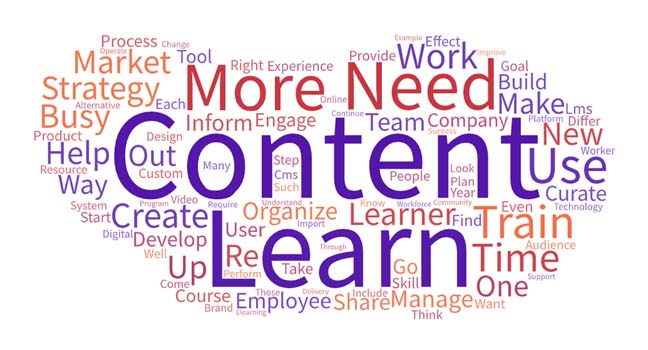
Figure 1: Learning Content Lit Review Word Cloud | Source: RedThread Research, 2021.
This word cloud illuminates several content-related trends.
- First, Figure 1 highlights the significance of the word “more.” With an ocean of learning content available to employees now, people are overwhelmed. This reality was eloquently described by one author who said:
eLearning content is being created and shared faster than you can blink. While today's employees want to direct their own learning, digital information overload can make that a difficult task without a roadmap.2
This content overload gives rise to the question:
With so much learning content available, how can employees easily find what they really need?
- The prominence of the word “need” in Figure 1 emphasizes the importance of enabling learning at the right time and place. For employees to learn in the flow of work, content must be easily accessible at the point of need.
- Finally, “strategy” in Figure 1 is noticeably smaller than some of the other terms. This reflects a trend we see in the literature: Content strategy is present but isn’t a fully developed concept with L&D quite yet. By contrast, it is a fully developed concept with marketing and enterprise content management—and we drew on some of the literature from these areas for this lit review.
To add to this analysis, the literature reflects 5 key themes:
- Content management tech doesn’t equate to a content strategy
- Marketing and enterprise content management offer lessons about content for L&D
- Democratizing content creation
- Should delivery modality dictate content decisions?
- Current literature says little about proprietary vs. nonproprietary content
Let’s dig deeper.
Content management tech doesn’t equate to a content strategy
Although many L&D articles reference content (CMSs) and learning content management systems (LCMSs), few address how to build a content strategy.
So what exactly is a content strategy? Author Chad Udell writes:
In its simplest terms, content strategy for formal learning is a holistic plan for content—the knowledge that you want the learner to receive and retain.3
A content strategy helps orgs be more intentional about the content learning leaders produce or acquire—typically to support the org’s business goals. It also helps keep content consistent and focused (including a consistent tone and voice—a form a branding). This focus stands in stark contrast to many orgs’ tendency to pump out more and more new learning content for the sake of content, ultimately overwhelming and misguiding employees.4
Hoping to make content more manageable and accessible for employees, some L&D orgs look to content management tech as the “silver bullet” answer—thinking their problems will be solved even if they implement the tech without a clear content strategy. This attempt often backfires—or at least dies a slow, quiet death—when nobody uses the tech.
So, instead of a tech-first approach, learning leaders must design a holistic plan for content—a content strategy—and set up any content management tech to support those larger goals.
A learning content strategy is not the same thing as a learning tech strategy: It’s not enough to buy new tech—orgs need to choose content to support their business and learning goals.
Marketing and enterprise content management offer lessons about content for L&D
Marketing offers relevant advice to the L&D world when thinking through questions related to content. If you swap “buyer” for “learner,” marketing-related resources can share key lessons for L&D on cultivating a consistent brand, conducting a needs analysis, and understanding one’s own audience when it comes to content.5 Both marketers and L&D practitioners need to understand:
- Who their audience is
- Why that audience needs our services
- What content we should provide
- When to trigger the buyer / learner to action
- Where buying / learning can best happen
Marketing offers relevant advice to the L&D world when thinking through questions related to content.
These ideas are captured well in Figure 2.
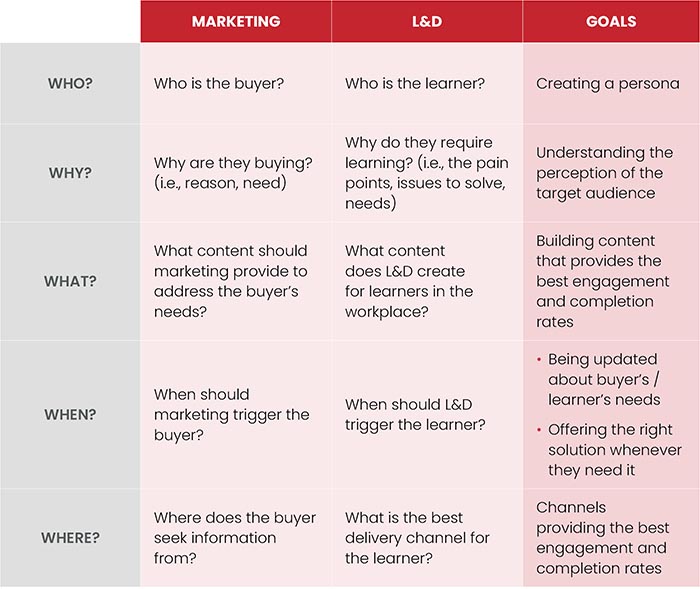
The 5Ws for Content Marketing & L&D | Medium.com, 2018.
Where marketing diverges from L&D is on the point of content ownership. While marketing typically has a central content team and a consolidated source of content operations, many orgs can’t centralize all learning content creation.6 L&D must figure out questions about learning content ownership without leaning on marketers’ experiences.
Where marketing offers insights into understanding our audience and cultivating a brand, enterprise content management focuses on standardization, governance, and modularity to enable orgs to create (or facilitate the creation of), manage, and personalize content at scale. Potential lessons for L&D from this area of the literature include:
- Personalization of content can only be scaled by standardizing content7
- Standardizing content requires breaking it into small, reusable component parts8
- Establishing clear processes for content creation and ownership—governance—is critical to successful content management9
Democratizing content creation
Content has traditionally been handled with a “top-down” methodology, with orgs deciding what employees need to learn, and then creating or providing the relevant content. However, approaches like user-generated content flip this traditional approach on its head. Now employees are encouraged to create learning content.
User-generated content taps into the idea that workers are already sharing information with their peers. One study found that this type of peer-sharing often occurs through answering questions via message or social network (39% of respondents), and through sharing articles, podcasts, and other mediums (37% of respondents).10 The thinking is:
Workers naturally share information with peers, so why not equip them to create content on behalf of the org?11
By actively engaging employees in the process of content creation, user-generated content also promotes learner engagement and satisfaction. The content also tends to be more relevant as it results from real employee needs and experiences.
However, user-generated content isn’t all sunshine and rainbows. While democratized content is proprietary, it’s also less centrally controllable than other proprietary content—bringing in questions about the quality and reliability of the content itself.12 Learning leaders need to ask questions about their role in user-generated content: How should L&D facilitate peer-sharing learning and / or conduct quality reviews of this type of content?
Should delivery dictate content?
Nobody knows—yet.
Different types of delivery options have become increasingly popular of late. Among these are microlearning, mobile learning, and VR: In fact, one recent study documented a 7% increase in mobile learning from 2019 to 2020.13 While the literature reflects this shift, many recent articles discuss how to best create content specific to delivery modalities.
The literature reflects a shift in the learning tech market toward specialized delivery methods—and offers lots of advice about how to create content specific to those methods.
One author, Dr. RK Prasad, offers insight into what a content strategy specific to microlearning could look like. He recommends that learning leaders should rely on gamification more than instructor-led training (ILT): This, he argues, would make learning content more digestible for employees and less expensive for orgs in the long term.14
Another article focused on how to create a content strategy for mobile learning, stressing the importance of the content “lifecycle” and the need to transform content to fit a mobile platform.15 Similarly, another source addressed content development for VR training, and detailed the 6 steps needed to convert content for VR and then test it via this medium.16
The question then becomes:
Should the delivery method change the nature of the content or should orgs make all content reusable, regardless of the original platform?
We couldn’t find any answers in the literature, so we plan to explore this question further in our research.
Current literature says little about proprietary vs nonproprietary content
Heading into this research, we hypothesized that the type of content (i.e., proprietary or nonproprietary) would change how orgs select, prioritize, deliver, and measure learning content.
One reason we believe the content type matters so much is that ownership of the content can change depending on the content type.
In many orgs, a central L&D team fully owns nonproprietary content related to topics like leadership development, while subject-matter experts (SMEs) outside of L&D own proprietary content related to org-specific intellectual property, systems, and processes. L&D may facilitate delivery of that content, but an SME is responsible for creating and maintaining it. User-generated content complicates matters further by distributing creation and ownership even more broadly thoughout the org.
This reality has serious consequences for content strategy, delivery, and measurement. So, for L&D, this means fully answering the question:
Who owns what learning content within the org?
- Should business SMEs be responsible for generating subject-specific content (e.g., related to processes, systems, intellectual property, etc.)?
- Should L&D own all content creation? Should L&D own any content creation?
- How does L&D’s role shift as it relates to both types of content (proprietary and nonproprietary)?
Unfortunately, we found little to no information in the literature weighing in on these questions. We look forward to exploring them in more depth as part of this research.
Top Sources Worth Reading
5 articles in the literature provided great insight into how learning leaders should be thinking of content, including taking advice from some marketing professionals. We found these sources helpful and encourage you to check them out:
10 Steps to Building a Successful Content Strategy
James A. Martin | CMS Wire, January 2018
The article, while initially created for marketing, outlines 10 key steps to creating a content strategy, including choosing the best tech and tailoring the right content for the job.
“To be successful, though, you can’t push out content ‘spray and pray’ style, hoping at least one piece hits its target audience in just the right way.”
Highlights:
- Choose the right tech that allows you to update content
- Be intentional about your target audience and build learner personas
- Conducting a content audit will increase engagement
- Cluster content into digestible chunks for employees
A Content Strategy Isn’t Just for Marketers
Bianca Baumann | Training Industry, Sept/Oct 2017
This article points out the steps L&D can take when creating and implementing a content strategy, pulling from parallels with marketing.
“Ultimately, having a strategy in place helps create meaningful, engaging and sustainable content, and allows to identify the right content at the right time for the right audience.”
Highlights:
- Leaders need to think through both the substance and structure of the content
- Leaders should consider workflow (e.g., resources needed) and governance (e.g., policies, decision-makers)
- Implementing a content strategy requires the following steps (resembling the ADDIE17 model):
- First, learning leaders need to identify a training gap (analysis), strategize before designing (strategy), and create a communication program upfront (plan)
- Next, leaders need to consider reusing content in different forms (create) and think through different learning modalities (deliver)
- Finally, leaders need to align measures with their org’s needs and objectives (measure) and make sure to keep content updated (maintain)
Reusing Content Is Key in Today's Quickly Changing Marketing Landscape
Anjali Yakkundi | CMS Wire, November 2020
This piece discusses how content can be reused by considering content assets to be more like Lego pieces than fixed creations, in order to adapt content to different delivery platforms. This Lego approach frees content creators from spending time updating, managing, and tailoring content—freeing them to focus on other activities like content strategy.
“By breaking down content to smaller, reusable chunks, marketing teams can more easily reuse, recombine and repurpose content to be used on multiple channels.”
Highlights:
- To democratize the learning, content owners should reuse the content and involve multiple team members in the process
- Content owners need to act with agility: They can use a “test-and-iterate" content strategy and be ready to shift priorities when required
- When repurposing content, it’s important to make any changes needed for the context in which the learning’s being presented to the target audience
Bringing Content Strategy into the Blend
Phylise Banner | TD Magazine, August 2017
This magazine article discusses how blended learning can be best served with a content strategy that addresses 3 domains: objective, content, and human.
“When content strategy is done well, no one notices that it’s there. They are too engaged with the experience—which is exactly what we want from our learners.”
Highlights:
- Content strategists need to:
- Create learner personas to describe and understand the attributes of employees
- Build an org-readiness matrix
- Conduct a content audit to analyze which types of content are working
- Understand workflow and governance by having a content lifecycle
- Identify a team to facilitate the learning culture and carry out the content strategy
User-Generated Content: Socialization of eLearning content
Satyabrata Das | eLearning Industry, December 2020.
This article lays out key advantages and disadvantages of user-generated content and the reasons why this type of content’s becoming increasingly popular.
Highlights:
- User-generated content’s gaining traction in formal learning (while it’s been popular in informal learning)
- Advantages of user-generated content include high engagement, greater relevance, and greater acceptability
- Disadvantages of user-generated content include dependency on a few users to generate content, questionable reliability and accuracy of the content, and incomplete coverage of relevant areas
Additional Reading Recommendations
- “Tip: Content Strategy for Continuous Learning,” Learning Solutions / Monica Kraft, 2014.
- "Delivering Personalized Experiences at Scale: Three Kinds of Output Types," Content Rules / Val Swisher, 2020.
- “Transforming L&D Content Into Immersive VR Training Tools,” eLearning Industry / Christopher Pappas, 2020.
- “Microlearning Content Strategy ROI: How To Maximize It With Gamification,” eLearning Industry / RK Prasad, 2020.
- “Engaging Learners Today: Five Key Takeaways from Content Marketing,”com / Vibons, 2018.
- “Why You Should Rethink Your Learning Content Management Strategy,” Cornerstone OnDemand, 2018.
Content in the 2020s: Enabling Learning
Posted on Tuesday, March 2nd, 2021 at 6:00 AM
Why We Care
We’ve been thinking, talking, and writing about the employee learning experience—its many parts and layers—for a long time. With past research, we’ve emphasized how critical it is for L&D to empower the entire employee learning journey: plan, discover, consume, experiment, connect, and perform.1
Content’s always been a major part of this learning journey—and the time has come to gain a better understanding of how current content trends are affecting learners and orgs alike:
With so much content available in so many places—and many more learners now attempting to access content remotely—L&D must get a handle on how to enable employees to have the right learning experiences.
By “right learning experiences,” we mean enabling learners to access the right content, at the right time, in the right format for their needs and situation. One big challenge: the “right learning experience” changes from employee to employee and from situation to situation.
A Flood of Learning Content
We’ve been witnessing rapid growth in the amount, types, and sources of content available to learners.
Until recently, almost all learning content was proprietary—created by a central authority (or authorities) in an org for employees of that org. First, we saw a boom in nonproprietary, third-party off-the-shelf content: Designed primarily for leadership development, it burst into areas like frontline training, sales, customer service, and much more.
Until recently, almost all learning content was proprietary. That's changed rapidly. Now there's a sea of content—proprietary and nonproprietary—that learners sometimes struggle to navigate.
Then user-generated content (a subset of proprietary content, but unique in that it's much harder to regulate) became a viable way to scale content creation and support collaborative learning for many orgs.
In response, we saw an increase in market demand for and vendor supply of user-generated content solutions. Figure 1 illustrates content types as we see them today.
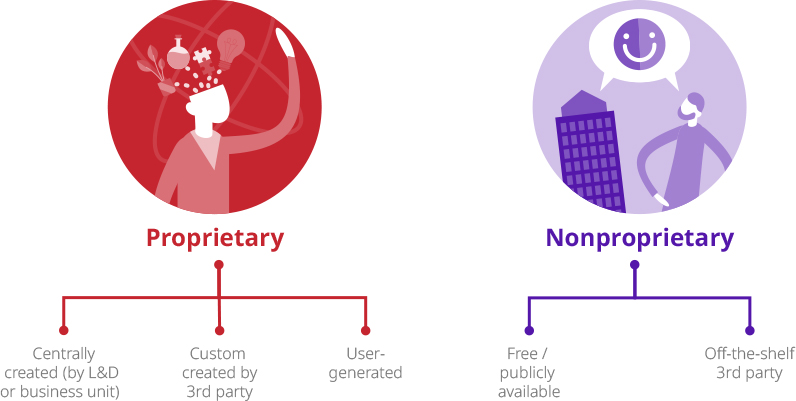
Figure 1: Current Understanding of Content Types | Source: RedThread Research, 2021.
Most recently, we’ve seen how L&D functions are struggling to account for (and tie to business goals) all the free, publicly available, uncontrolled content floating out there on the internet—that their learners are accessing and using.
As employees accessed more content in more ways, many L&D teams assumed (incorrectly) that more is better. They focused on giving learners access to all the content they could—proprietary and nonproprietary—including the proverbial kitchen sink. This strategy, they reasoned, would guarantee learners access to the content they needed!
Everything & the Kitchen Sink Just Doesn’t Work
In recent years, and especially with more employees working from home since COVID-19’s onset, the provide-everything content approach has shown its weaknesses—not the least of which is flooding learners with just too much.
- Cause: Employees are overwhelmed by the amount of content at their fingertips and struggle to navigate to what they really need.
- Effect: This situation discourages many employees from taking advantage of learning opportunities, ultimately hindering their performance and the org’s.
Providing tons of content also makes it difficult to ensure employees access the best (most relevant, highest quality) content or the content that most closely supports organizational priorities.
For example, let’s say the best content for a given employee and situation is a proprietary document created by a central L&D professional. But the easiest-to-access content is a public, nonproprietary video on YouTube. Which content is the employee more likely to consume? Probably the YouTube video—which isn’t ideal for the employee’s development or the org’s goals. This type of situation presents a challenge for L&D.
Learning depends not only on what the content is, but also on how it’s accessed.
There’s a growing recognition that learning depends not only on what the content is, but also on how it’s accessed. Successful learning means employees get the right content, yes—but they also get that content at the right time and in the right format / modality (in-person, virtual, mobile, coaching, on-the-job practice, etc.).
What We’ll Research
The challenge facing L&D has become:
How can orgs continually enable learners to access the right content, at the right time, in the right format—in short, to have the right (best) learning experience?
We want to understand this question in detail, with a focus on how the answers change based on content type—proprietary or nonproprietary. We sense that content type strongly influences what the "right content" is and how it should be delivered. In particular, we hope to understand:
- How orgs identify / select content that meets both critical org priorities and individual employee needs
- How orgs manage content to be delivered whenever / however it’s needed
- How orgs prioritize content so as not to overwhelm learners (i.e., identify the best content for a particular situation)
- How orgs tie all of these varied ways of learning to improvements in key business outcomes
- How these answers change based on content type (proprietary / nonproprietary)
How You Can Participate
Be an active part of our learning content research—here’s 3 ways:
- Join us for the roundtable. We’ll be hosting a roundtable on this topic—we’re looking for forward-thinking leaders to participate. The roundtable will be held on Tuesday, April 13 from 11am ET to 12:20pm ET. Apply to participate here.
- Let us interview you! Tell us what your org’s doing and how you're approaching content challenges. Reach out to us at [email protected].
- Join the conversation. Read our research and tell us what you think! Leave a note below or send us an email. Your comments make us smarter and the research better.

